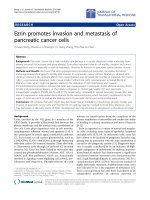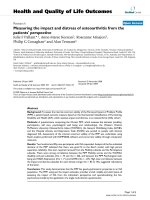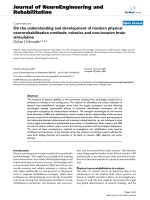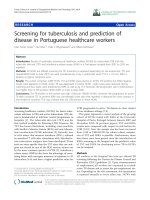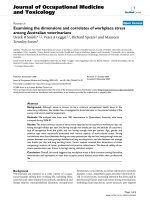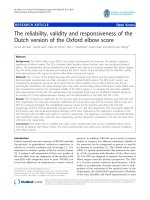Báo cáo hóa học: " Field Emission Properties and Fabrication of CdS Nanotube Arrays" pot
Bạn đang xem bản rút gọn của tài liệu. Xem và tải ngay bản đầy đủ của tài liệu tại đây (582.67 KB, 7 trang )
NANO PERSPECTIVES
Field Emission Properties and Fabrication of CdS Nanotube
Arrays
Xuemin Qian Æ Huibiao Liu Æ Yanbing Guo Æ
Shiqun Zhu Æ Yinglin Song Æ Yuliang Li
Received: 23 February 2009 / Accepted: 14 April 2009 / Published online: 5 May 2009
Ó to the authors 2009
Abstract A large area arrays (ca. 40 cm
2
) of CdS nano-
tube on silicon wafer are successfully fabricated by the
method of layer-by-layer deposition cycle. The wall
thicknesses of CdS nanotubes are tuned by controlling the
times of layer-by-layer deposition cycle. The field emission
(FE) properties of CdS nanotube arrays are investigated for
the first time. The arrays of CdS nanotube with thin wall
exhibit better FE properties, a lower turn-on field, and a
higher field enhancement factor than that of the arrays of
CdS nanotube with thick wall, for which the ratio of length
to the wall thickness of the CdS nanotubes have played an
important role. With increasing the wall thickness of CdS
nanotube, the enhancement factor b decreases and the
values of turn-on field and threshold field increase.
Keywords CdS Á Nanotube arrays Á
Layer-by-layer deposition Á Field emission
Introduction
One-dimensional semiconductor nanostructures have been
intensively investigated in recent years due to their inter-
esting optical and electronic properties, and promising
applications in nanoscale devices [1–3]. Among the II–VI
semiconductors, CdS has been attracted special interest
because it exhibits high photosensitivity and its band gap
energy (2.41 eV) appears in the visible spectrum leading to
many commercial or potential applications in light-emit-
ting diodes, solar cells, field emitter, and other photoelec-
tric devices [4–8]. To date, CdS nanotubes are synthesized
via the sol–gel or electrophoretic processing combination
of molecular anchor template and various porous mem-
branes including anodic aluminum oxide, polycarbonate,
and mesoporous silica. [9–12] In fact, the CdS nanotubes
prepared by above-mentioned methods are always free
standing, and impossible to be directly used to fabricate
nanodevices, because they cannot orderly locate on the
solid surface after the removal of the templates. Therefore,
the controlling growth of aligned CdS nanotubes and get-
ting ordered nanostructures on conductive substrates by a
facile and versatile synthetic method is still a challenge. In
this work, a large area of CdS nanotube arrays on silicon
wafer is successfully fabricated by the method of layer-by-
layer deposition using well-aligned ZnO nanorod arrays as
removable templates. The wall thicknesses of CdS nano-
tubes are precisely tuned by controlling the cycles of layer-
by-layer deposition. The field emission (FE) properties of
CdS nanotube arrays are investigated. The results indicate
that the FE properties of CdS nanotube arrays can be
X. Qian Á S. Zhu Á Y. Song (&)
School of Physical Science and Technology, Suzhou University,
Suzhou, Jiangsu Province 215006, People’s Republic of China
e-mail:
X. Qian
e-mail:
S. Zhu
e-mail:
X. Qian Á H. Liu (&) Á Y. Guo Á Y. Li
Beijing National Laboratory for Molecular Sciences (BNLMS),
CAS Key Laboratory of Organic Solid, Institute of Chemistry,
Chinese Academy of Sciences, Beijing 100190,
People’s Republic of China
e-mail:
Y. Guo
e-mail:
Y. Li
e-mail:
123
Nanoscale Res Lett (2009) 4:955–961
DOI 10.1007/s11671-009-9324-8
controlled through changing the wall thicknesses of CdS
nanotubes. With increasing the wall thicknesses of CdS
nanotubes, the enhancement factor b decreases and the
values of turn-on field and threshold field increase.
Experimental Details
Scheme 1 shows a schematic illustration of the fabrication
processes of CdS nanotube arrays by the method of layer-
by-layer deposition. A typical synthetic procedure is car-
ried out as follows. The ZnO nanorod arrays are prepared
on a silicon wafer through a hydrothermal process [13].
Then, the wafer with ZnO nanorod arrays is immersed in an
aqueous solution of 0.05 M cadmium nitrite. In this pro-
cess, the Cd
2?
nuclei will adhere to the lattice site on the
surface of ZnO nanorods. After 5 min, the wafer is taken
out from the solution and washed with deionized water for
3 times. Then, the wafer is dipped into an aqueous solution
of 0.05 M sodium sulfide for 5 min resulting in the Cd
2?
reacting with S
2-
to form CdS nuclei on the surface of ZnO
nanorod. Subsequently, the wafer is washed with deionized
water for 3 times. Repeating the above-mentioned process
for 3 times, the wafer becomes slightly yellow, which
indicates the CdS layer on the surface of ZnO nanorods is
formed. Three kinds of ZnO/CdS core/shell nanorod arrays
with different thicknesses of CdS shell are prepared by
above-mentioned process for 6 (sample C), 9 (sample B),
and 12 (sample A) deposition cycles, respectively. Then,
three samples are immersed in the aqueous solution of 1 M
sodium hydroxide to remove the ZnO nanorods, respec-
tively. After removing the ZnO nanorods, the wafers show
the bright yellow of CdS nanotubes.
The arrays of CdS nanotubes are characterized and
analyzed by field emission scanning electron microscopy
(FESEM, Hitachi, S-4300), transmission electron micros-
copy (TEM, JEOL, JEM-1011), energy-dispersed X-ray
microanalysis system (EDXA, Oxford Instrument, UK),
Fluorescence spectrophotometer (Hitachi, F-4500), and
X-ray diffraction (XRD). The XRD patterns are recorded
with a Japan Rigaku D/max-2500 rotation anode X-ray
diffractometer equipped with graphite-monochromatized
Cu Ka radiation (k = 1.54178 A
˚
), employing a scanning
rate of 0.05°s
-1
in the 2h range from 20° to 60°. The FE
properties of CdS nanotube arrays are measured using a
two-parallel-plate configuration in a homemade vacuum
chamber at a base pressure of *1.0 9 10
-6
Pa at room
temperature. The sample is attached to one of stainless-
steel plates as cathode with the other plate as anode. The
distance between the electrodes is 300 lm. A direct current
Scheme 1 The schematic
illustration of the fabrication
processes of CdS nanotube
arrays
Fig. 1 SEM images of ZnO
nanorod arrays a the top view,
b the cross-sectional view.
c The XRD pattern of ZnO
nanorod arrays
956 Nanoscale Res Lett (2009) 4:955–961
123
voltage sweeping from 0 to 5000 V was applied to the
sample at a step of 50 V. The emission current is moni-
tored using a Keithley 6485 picoammeter.
Results and Discussion
The morphologies of pre-synthesized ZnO nanorod arrays
are first examined by SEM. Figure 1a shows that the ZnO
nanorods present a well-defined hexagonal shape with uni-
form diameter of about 126 nm. The cross-sectional view of
SEM image (Fig. 1b) shows the ZnO nanorods align on the
silicon wafer with a length of about 1.5 lm. Such highly
alignment of ZnO nanorods are further confirmed by its
corresponding XRD analysis. As shown in Fig. 1c, the XRD
pattern is dominated by a very sharp and strong (002)
reflection of wurtzite-type ZnO, which indicates the ZnO
nanorods are grown in the preferentially direction of [0001].
After the 12 cycles of deposition CdS and subsequent ZnO
nanorods template removal, the olivaceous film changes to
light yellow and remains on the silicon wafer. Figure 2a
shows that the photograph of large area light yellow CdS
nanotube arrays (sample A), which are up to 40 cm
2
on size.
Figure 2b displays that the XRD pattern of sample A which
is dominated by characteristic (002), (102), and (110)
reflections of wurtzite-type CdS, which indicates the crystal
of as-synthesized CdS nanotube. The EDAX pattern
(Fig. 2c) shows that there are just S and Cd elements in the
nanotubes, which confirms that the ZnO nanorods are
completely removed. The quantitative analysis of EDAX
pattern indicates that the atomic ratio of Cd and S in the
nanotubes is about 1:1. The room temperature photolumi-
nescence (PL) measurement of the CdS nanotube arrays are
shown in Fig. 2d. A green emission band around 550 nm
and a red emission band around 750 nm [14] are observed.
The PL intensities of CdS nanotube arrays enhance with
increasing the deposition cycles. As shown in Fig. 2e and f,
the SEM images reveal that the light yellow film deposited
on the surface of silicon wafer consists of perfectly aligned
hexagonal CdS nanotube arrays. The hexagonal CdS
Fig. 2 a Photograph of sample
A. b The XRD pattern of
sample A. c The EDAX spectra
of sample A. d PL spectrum of
CdS nanotube arrays at room
temperature, k
ex
= 504 nm.
The SEM images of sample A
e top view, f cross-section view
Nanoscale Res Lett (2009) 4:955–961 957
123
nanotubes resulting from the ZnO nanorod arrays have the
average external diameters of 166 ± 7 nm (Fig. 2e), and all
of nanotubes exhibit opened ends. The inset of Fig. 2e dis-
plays that their walls are very smooth about 20 ± 3nmin
thicknesses. Figure 2f shows the products present hollow
structures vertically standing on the silicon wafer with a
length of about 1.5 lm. When the deposition decreased to
nine cycles, CdS nanotube arrays (sample B) are also
obtained. Figure 3a shows that the average external diam-
eters of CdS nanotubes are about 154 ± 5 nm, which are
less than that of sample A (166 ± 7 nm). All of nanotubes
exhibit opened ends in sample B. The wall thicknesses of
CdS nanotubes (sample B) decrease to ca 15 ± 2.5 nm
(Fig. 3b). With decreasing the deposition to six cycles, the
arrays of CdS nanotube (sample C) with thinner wall
thicknesses of 10 ± 1.5 nm are prepared, whose external
diameters decrease to 140 ± 3 nm (Fig. 3d).
To explore construction forms of CdS nanotubes, the
TEM measurements are performed. Figure 4a is a typical
TEM image of CdS nanotube arrays (sample A). The
nanotubes are uniform with an external diameter of about
166 nm and length of about 1.5 lm. Figure 4b shows a
TEM image of typical individual CdS nanotube (sample A)
with ca 166 nm of external diameter and the thickness of
wall is about 20 nm. The selected area electron diffraction
(SAED) pattern exhibits that the CdS nanotube (sample A)
is polycrystal (the inset of Fig. 4b). As shown in Fig. 4c,
the external diameters of CdS nanotubes (sample B) are
about 154 nm and the open nanotube is clearly observed.
The thicknesses of wall decrease to about 15 nm. The
SAED pattern presents the CdS nanotube (sample B) also
is polycrystal (the inset of Fig. 4c). Figure 4d shows that
the external diameter of CdS nanotube (sample C) is about
140 nm and the thickness of wall is only about 10 nm. The
inset of Fig. 4d indicates that the CdS nanotube (sample C)
is polycrystal.
The FE measurements of CdS nanotube arrays depen-
dence on wall thicknesses of nanotubes were firstly per-
formed. The typical plot of the FE current density J versus
the applied electric field (J–E) and the corresponding
Fowler–Nordheim (F–N) plots of those CdS nanotube
arrays are illustrated in Fig. 5a and b, respectively. The FE
parameters are listed in Table 1. Here we define the turn-on
field (E
to
) and the threshold field (E
th
) as the applied
electric fields required to produce a current of 10 lA/cm
2
and 1 mA/cm
2
, respectively. E
to
for sample A is 11.33
V/lm. With decreasing the wall thicknesses of CdS
nanotubes, the E
to
of samples B and C decrease to 9.99 and
7.99 V/lm, respectively. With decreasing the wall thick-
nesses of CdS nanotubes, the E
th
decreases. E
th
for samples
A, B, and C are 14.92, 13.44, and 11.27 V/lm, respec-
tively. The maximum emission density of sample A is
3.9 mA/cm
2
, which is higher than that of sample B
(3.28 mA/cm
2
) and C (2.97 mA/cm
2
).
To further analyze the FE properties of the CdS nano-
tube arrays, the class Fowler–Nordheim (F–N) law [15],
Fig. 3 SEM images of CdS
nanotube arrays. a The low
magnification SEM image
of sample B. b The high
magnification SEM image of
sample B. c The low
magnification SEM image
of sample C. d The high
magnification SEM image of
sample C
958 Nanoscale Res Lett (2009) 4:955–961
123
Fig. 4 a The low magnification TEM image of CdS nanotube arrays of sample A. TEM images of b, c, and d are high magnification TEM
images of A, B, and C, respectively. The inset images are SAED patterns of corresponding CdS nanotube
Fig. 5 a Field emission J–E curve of CdS nanotube arrays. b The corresponding F–N plot of CdS nanotube arrays
Nanoscale Res Lett (2009) 4:955–961 959
123
which was induced on the base of the electron emission
properties from a semi-infinite flat metallic surface, was
used to describe the relationship between the J and the
local field E
local
nearby the emitter which is usually related
to the average applied field E as follows:
E
local
¼ bE ¼ b
V
d
ð1Þ
where d is the inter-electrode spacing, V is the applied
voltage, and b is the enhance factor. The F–N law is
expressed as:
J ¼ a
b
2
E
2
/
exp
Àb/
3=2
bE
!
ð2Þ
where a¼1:54Â10
À6
AV
À2
; b ¼6:83 Â10
9
Vm
À1
eV
À3
=
2
;
and / is the work function, which is estimated as 4.2 eV
for CdS [16]. The b can be determined by fitting the slope
value and taking a reasonable value. For those CdS
nanotube arrays, the F–N plots (Fig. 5b) show a
linear relationship, implying that a quantum-tunneling
mechanism is responsible for the emission. As illustrated
in Table 1, the b for sample C (625) is higher than that of
samples A (276) and B (372). It is well-known that the b is
not only determined by the aspect ratio but also by the ratio
of length to the wall thickness for the tube-like emitters
[17, 18]. An empirical formula is obtained according to
Kokkorakis’ model: [17, 18]
b ¼ m Ã
l
r
þ n Ã
l
t
þ c ð3Þ
where m, n, and c are alterable parameters. The r is the
average radius of nanotube, l is the length of nanotube, and
t is the thickness of wall. The b is determined by two
factors, aspect ratio l/r and the ratio of length to wall
thickness l/t. For getting the values of three parameters, we
must use formula 3 to fit the values of b which are obtained
in experiment. The parameters m, n, and c are obtained as
0.9, 3.7, and 6, for the best fit to the experimental datum.
Using these parameters, we get three simulating values of
b
sim
for samples A, B, and C, which are 273, 359, and 642,
respectively. They are consistent with the experiment val-
ues. In our case, l/r of those CdS nanotube arrays are
almost same and the value of parameter n is larger than
parameter m, which means l/t is the key role to determine
the FE properties of CdS nanotube arrays. The FE prop-
erties of CdS nanotube arrays increase with the increase of
l/t. The length of samples A, B, and C are almost same, so
the arrays of CdS nanotube with the thinner wall exhibit the
better FE property.
Conclusions
A large area of CdS nanotube arrays is fabricated by a
facile way of layer-by-layer deposition. The wall thick-
nesses of nanotubes are controlled by tuning the deposition
cycles. The FE properties of CdS nanotube arrays depen-
dence on wall thicknesses are investigated and show
infusive and regular results. With decreasing the wall
thicknesses of CdS nanotubes, the value of E
to
and E
th
decrease and b increases. The thinnest walls of CdS
nanotubes exhibit the least value of E
to
and E
th
for prom-
ising candidate materials on field emitters and nanodevices.
Acknowledgments This work was supported by the National Nat-
ure Science Foundation of China (20531060, 20473102, and
20571078) and the National Basic Research 973 Program of China.
References
1. J.S. Jie, W.J. Zhang, Y. Jiang, X.M. Meng, Y.Q. Li, S.T. Lee,
Nano. Lett. 6, 1887 (2006). doi:10.1021/nl060867g
2. A.M. Morales, C.M. Lieber, Science 279, 208 (1998). doi:
10.1126/science.279.5348.208
3. X.F. Duan, Y. Huang, R. Agarwal, C.M. Lieber, Nature 21, 6920
(2003)
4. O. Hayden, A.B. Greytak, D.C. Bell, Adv. Mater. 17, 701 (2005).
doi:10.1002/adma.200401235
5. I. Visoly-Fisher, S.R. Cohen, D. Cahen, C.S. Ferekides, Appl.
Phys. Lett. 83, 4924 (2003). doi:10.1063/1.1632532
6. N. Kouklin, L. Menon, A.Z. Wong, D.W. Thompson, J.A.
Woollam, P.F. Williams, S. Bandyopadhyay, Appl. Phys. Lett.
79, 4423 (2001). doi:10.1063/1.1427156
7. Y.F. Lin, Y.J. Hsu, S.Y. Lu, S.C. Kung, Chem. Commun. 22,
2391 (2006). doi:10.1039/b604309g
8. Z.H. Yin, Y.Z. Long, C.Z. Gu, M.X. Wan, J.L. Duvail, Nanoscale
Res. Lett. 4, 63 (2009). doi:10.1007/s11671-008-9203-8
9. C.N.R. Rao, A. Govindaraj, F.L. Deepak, N.A. Gunari, Appl.
Phys. Lett. 78, 1853 (2001). doi:10.1063/1.1359145
10. T.Y. Peng, H.P. Yang, K. Dai, X. Pu, K. Hirao, Chem. Phys. Lett.
379, 432 (2003). doi:10.1016/j.cplett.2003.08.059
11. X.P. Shen, A.H. Yuan, F. Wang, J.M. Hong, Z. Xu, Solid State
Commun. 133, 19 (2005). doi:10.1016/j.ssc.2004.09.053
12. S.M. Zhou, Y.S. Feng, L.D. Zhang, Eur. J. Inorg. Chem. 1794
(2003). doi:10.1002/ejic.200200593
13. L. Vayssieres, Adv. Mater. 15, 464 (2003). doi:10.1002/adma.
200390108
14. H.B. Liu, Y.L. Li, H.Y. Luo, H.J. Fang, H.M. Li, S.Q. Xiao, Z.Q.
Shi, S.X. Xiao, D.B. Zhu, Eur. Phys. J. D 24, 405 (2003). doi:
10.1140/epjd/e2003-00188-3
Table 1 The field emission properties of CdS nanotube arrays
Sample l/t l/r E
to
(V/lm) E
th
(V/lm) b
exp
b
sim
A 75 18 11.33 14.92 276 273
B 100 19.5 9.99 13.44 372 359
C 150 21.4 7.99 11.72 625 642
r the average radius, t the thickness wall of CdS nanotube, l the length
of nanotube, b
exp
the value of enhancement factor obtained by
experiment data, b
sim
the simulation value of enhancement factor
960 Nanoscale Res Lett (2009) 4:955–961
123
15. R.H. Fowler, L.W. Nordheim, Proc. R. Soc. Lond. A 119, 173
(1928). doi:10.1098/rspa.1928.0091
16. J.B. Cui, K.B. Teo, J.T.H. Tsai, J. Robertson, W. Milne, Appl.
Phys. Lett. 77, 1831 (2000). doi:10.1063/1.1310628
17. G.C. Kokkorakis, A. Modinos, J.P. Xanthakis, J. Appl. Phys. 91,
4580 (2002). doi:10.1063/1.1448403
18. G.C. Kokkorakis, J.A. Roumeliotis, J.P. Xanthakis, J. Appl. Phys.
95, 1468 (2004). doi:10.1063/1.1638617
Nanoscale Res Lett (2009) 4:955–961 961
123
